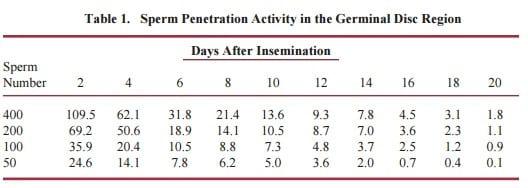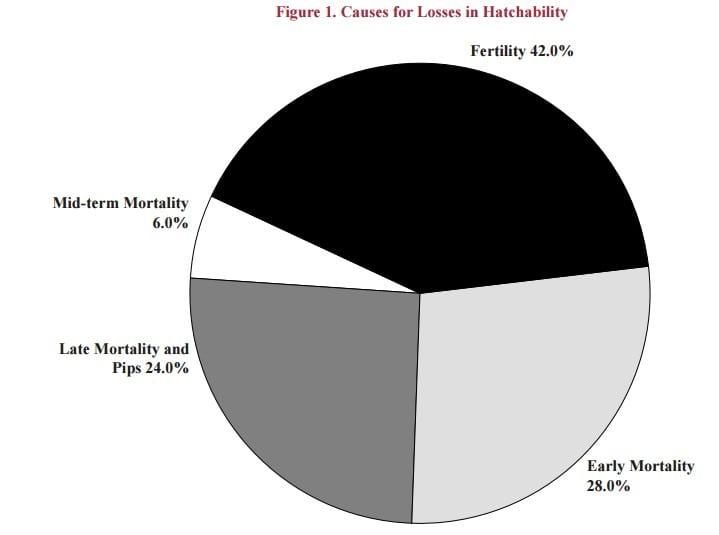Fertility and Embryonic Mortality in Breeders
Observations in Figure 1 were reported by The University of Georgia and support the importance of fertility and its negative influence on hatchability. Obviously, these data indicate that fertility is the primary factor resulting in fewer chicks hatched per hen housed since even the best incubators and hatchery management procedures can not produce chicks from infertile eggs! In addition, losses in hatch due to early dead embryos often occur concurrently with a reduction in fertility. Thus, in order to more effectively manage flock fertility, it is beneficial to have a better understanding of the series of events which occur prior to and at the site of fertilization in the avian egg.
Fertilization
Successful fertilization in birds occurs following a culmination of a series of events between properly grown breeder males and females. These events, in order, are: the physical act of mating, sperm storage within the hen, sperm transport within the oviduct, recognition of and penetration through the wall of the ovum, and the successful joining of the male and female gamete.
Under natural mating conditions, the physical act of mating is often proceeded by courtship which is sometimes very brief. Nevertheless, the physical act of mating, or copulation, is the first actual step in the fertilization process. A necessary component to successfully completed matings is maintaining male breeders which have the desire, or libido, to continue to mate throughout the life of the flock. When the mating process occurs normally, semen is deposited by the male in the hen’s cloaca at the rate of approximately 100 to 200 million sperm per ejaculation. Mating must occur frequently enough to ensure that relatively fresh and viable sperm are available to the hen at the time she ovulates. However, avian sperm do have an extended fertilizable life span due to the presence of sperm storage glands located in the hen’s oviduct. This allows for stored sperm to travel from these storage tubules to the infundibulum (the site of ovulation and fertilization) at the appropriate time. Although the ability for sperm to be maintained in these storage sites eliminates the need for fertilization on a daily basis, frequent matings insure the availability of fresh, high quality semen in the fertilization process.
After the sperm cell has arrived at the site of fertilization, the male gamete, or sperm cell, must recognize the appropriate sites on the outer surface of the ovum prior to its passage through this outer wall. After recognizing the appropriate sites on the ovum, through enzymatic action (called an acrosome reaction) the sperm cell creates a hole, or pathway, through which it passes into the ovum (this process is referred to as sperm penetration). If the sperm cell passes through the outer layer of the ovum in the germinal disc region, it gains access to the female genetic material, or pronuclei. After gaining entrance into the egg, syngamy, or joining of the male and female gametes, can occur. Following these steps, the avian egg has been successfully fertilized; and, given the proper incubational conditions, embryonic development may begin.
Assessing Reproduction in Breeder Flocks
There are several common methods for assessing the reproductive characteristic of breeder flocks. Reproduction in breeders is usually evaluated in the hatchery as part of an egg candling and egg breakout program. Results of an egg candling and breakout program reveal flock by flock patterns and fluctuations in embryonic mortality, embryo abnormalities, fertility, hatchability, hatch of fertiles, and contamination. Other programs can reveal egg shell quality, and egg pack qualities such as percent small end up, dirty eggs, off size or misshaped eggs, farm cracks, etc. On farm egg breakouts can also be used to immediately assess flock fertility without incubation in certain situations. However, the results of all this information must be tabulated and evaluated in order to improve flock performance.
There are generalities associated with some of these data. There is a relationship between the condition of hatching eggs brought into the hatchery and breeder house conditions. Poor egg pack can be attributed to on farm house conditions, frequency of egg collection, as well as time and care taken during on farm egg grading. Fertility is understandably related directly to the current status of the breeder flock and/or a result of lingering conditions related to the grow out phase of pullet and cockerel production. Although the breeder flock itself can affect hatch of fertiles, hatch of fertiles is often determined by the conditions the eggs are subjected after lay as well as during the storage, transportation and incubation processes.
Fertility & Embryonic Mortality
Most individuals involved in reproduction of animals are familiar with the common conception that “it only takes one sperm to fertilize an egg.” While this is true in mammals, it is only partly true in the avian world. While it may be true that a single sperm is all that is necessary to fertilize an avian egg, the conditions which cause low sperm numbers or single sperm activity at the site of fertilization can cause reductions in the actual number of chicks hatched. When few sperm are available to fertilize an egg in broiler breeders there is an associated reduction in fertility as well as an increase in early embryonic mortality. This is a common occurrence in flocks of older breeder hens or any other flock experiencing infrequent mating activity.
As previously mentioned, during natural mating, approximately 100 to 200 million sperm are deposited in the oviduct of the hen. Using the technique of counting the holes in the ovum caused by sperm penetration, a study was conducted in which hens were artificial inseminated with either 400, 200, 100, or 50 million sperm. In this study, eggs were collected and evaluated each day following a single insemination until sperm penetration activity ceased. The intent was to determine how rapidly the sperms’ ability to fertilize eggs decreased following insemination.
As shown in Table 1, sperm penetration in the germinal disc region decreased rapidly with time and sperm concentration. In the groups of hens inseminated with what may be considered a normal dose of semen (100 or 200 million sperm), 8 to 10 days following insemination average sperm activity dropped below 10 holes or sperm penetration sites. Two weeks following insemination, both groups averaged less than 5 holes created by this sperm activity. In situations in which more than normal numbers of sperm are deposited in the hens (400 million sperm dose), 12 to 14 days must elapse between matings before numbers under 10 sperm penetration sites are observed. Consequently, under normal conditions it may be understood that anything less than 10 sperm holes indicates a situation where infrequent mating has occurred. In short, few sperm available to fertilize an egg is a result of less frequent mating activity.
Table 1. Sperm Penetration Activity in the Germinal Disc Region
Previous research has indicated that old, stale sperm in the oviduct is associated with poor chick quality and early embryonic mortality. Old, stale sperm is sperm that has been inseminated in the hen and stored in the storage tubules of the hen’s oviduct for an extended period of time and not to old sperm at the time of insemination or sperm from old males. As part of the previously mentioned study, the relationship between the decrease in fertility due to days post insemination and early embryo mortality of fertile eggs was examined. In this experiment, hens were inseminated with one of two normal doses of semen, either 100 or 200 million sperm. Fertility, and early embryonic mortality (0 to 3 days) was measured until the cessation of fertility at 22 days following insemination. As can be seen in Table 2, as fertility decreased in succeeding days following insemination, early embryonic mortality of fertile eggs increased in both groups of hens beginning 12 days after the initial insemination. This is not due to few sperm, but, as has been seen in similar trials, to sperm residing within the hen’s storage tubules for an extended period of time. Thus, time causes both a decrease in the number of sperm available to fertilize, and an increased occurrence of in embryo death.
Table 2. Fertility and Embryonic Mortality
Essentially, 12 days after mating, early embryo mortality begins to rise with up to 10 percent of the fertile eggs dying during the first three days of development. The situation gets worse 16 to 18 days after mating when as much as 93 % of eggs fertilized at this point die during the first three days of development. Interestingly, actual embryo mortality does not increase as drastically because there are fewer developing embryos due to lower fertility. So does it take more than one sperm to fertilize an egg? Not necessarily. Does it take more than one sperm to ensure an egg has the potential to produce a viable quality chick? Yes, absolutely.
Summary
Understanding the relationship between fertility and early embryonic mortality as it relates to the production of quality chicks is important when trying to improve hatchability. As flocks age, mating frequency decreases, fertility decreases, and embryonic mortality increases. Part of the increase in embryonic mortality and decrease in hatch in older hens is undoubtedly due to reduced shell quality and other associated factors. Often times the declining egg production and other flock conditions cause a reduction in interest and attention from the grower. As conditions deteriorate in the flock due to age, attention to detail often subsides and additional hatching egg quality problems result. Problems such as unidentified farm cracks which affect moisture loss in the incubating egg, poor sanitation resulting in contaminated hatching eggs, or simply poor egg handling resulting in weak embryos. However, in addition to the conditions previously mentioned, frequent mating activity must be maintained in breeders throughout the life of the flock as infrequent mating not only results in poor fertility, but reduced hatch of fertiles due to losses from early embryo mortality. Although these factors are very commonly seen in flocks as they age, it is much more costly when these problems arise while the flocks are near peak production or shortly thereafter.
Figure 1. Causes for Losses in Hatchability
These data indicate that fertility is the primary factor resulting in fewer chicks hatched per hen housed since even the best incubators and hatchery management procedures can not produce chicks from infertile eggs!
Dear sir,
This article was very interesting. If we remove 8% of over weight(over 5Kg) males from the males at 35wks and introdused average weight new males can it affect to hatcherbility and how long will it take to recover?
dear sir,
good article but if it had been correlated with actual farm conditions it would have been much better.
normally breeder companies do their best in preparation of feed, disease prevention, egg storage and egg transportation. now the problem is that if we don,t have younger males what should we do. i think here comes male management. if we remove heavier males making them leaner and again introducing them in the sheds if it does not increase fertility it will maintain fertility for quite considerable time. i have done it with some success. waiting for every ones opinion.


Dear sir,
Thank you for your nice article. As flocks ages mating frequency decreases, fertility decreases, and embryonic mortality increases. This can be avoided by nutritional management as addition of essential fatty acids as omega 3 and/or omega 6, or by spiking younger male at the age of 40th week. Shell quality can be improved by controlling the egg size and increasing Ca in feed and pay attention to available phosphorous. The egg storage at farm plays an important role in hatchability, embryonic mortality, much emphasis should be given at farm while storage before despatching eggs to hatchery. Transportation of these eggs also a factor which can minimize hatchability. Some flock diseases can affect the fertility and hatchability, also seasonal and climate conditions.

As flocks ages mating frequency decreases, fertility decreases, and embryonic mortality increases. This can be avoided by spiking younger male at the age of 40th week. Shell quality can be improved by controlling the egg size and increasing Ca in feed. The egg storage at farm plays an important role in hatchability, embryonic mortality, much emphasis should be given at farm while storage before despatching eggs to hatchery. Transportation of these eggs also a factor which can minimize hatchability.




















.jpg&w=3840&q=75)